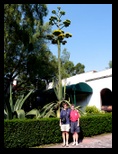
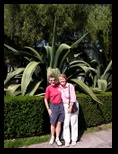
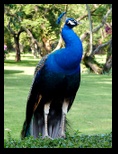
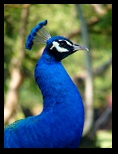
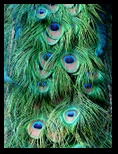
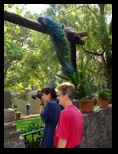
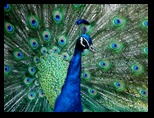
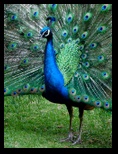

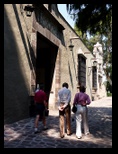
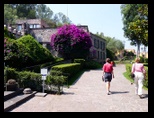
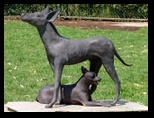
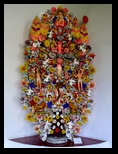
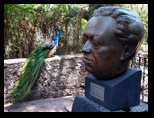
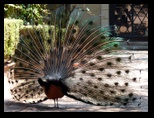
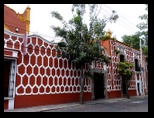

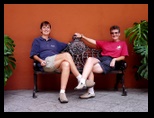
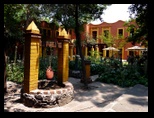
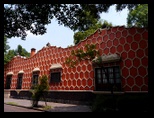
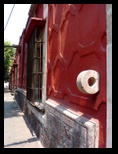

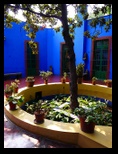
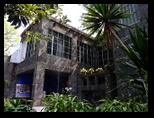
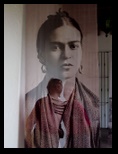

Click on a photo to enlarge it.
On Tuesday there is no entrance fee for the Dolores Olmedo Patiño Museum - our next Must-See destination in Mexico City.
Art collector and philanthropist Dolores Olmedo left her former home, the grand Hacienda La Noria, as a museum featuring the works of her friend Diego Rivera. At least
137 of his works are displayed here, including his portrait of Olmedo, 25 paintings of Frida Kahlo, and 37 creations of Angelina Beloff (Rivera's first wife),
many of them drawings and engravings.
Olmedo was the executor of both the Rivera and Kahlo estates, a close friend and former lover of Diego's, and a rival to Frida. Olmedo died in 2002, recognized as
one of the most astute collectors of contemporary Mexican art.
Annette once met her personally. She also knows the curator of the museum. We were just inside the museum when he crossed our path and recognized Annette. Senior Licienciado Gil Rodríguez Reyes
invited us for coffee and cake and told us the story of Dolores Olmedo. We also got a book about the life of this impressive woman for free. Dolores Olmedo was the first woman to run a
huge company in Mexico. She owned all the brickwork companies around Mexico City and through her contacts with the high society - among them Mexican President Miguel Alemán - built a lot of
suburbs in Mexico City. She donated her home in 1994 to the public.
Senior Reyes also reminded Annette that she promised 10 years ago to invite him for pigs trotters with sauerkraut. Ooops! What a memory! Annette made a quick decision and invited him and his wife for next Saturday.
When he learned about our life in the motor home, he gave us the nick name "Las pipiripaus", which means globetrotters.
After the refreshments we went to see the museum. It is built into a seventeenth-century mansion. Unfortunately Frida Kahlo´s paintings are currently in Berlin (how typical!) but the museum was still worth seeing.
Besides the paintings, there are fine pre-Hispanic pieces on display, colonial furniture and other hacienda artifacts, and a collection of folk art.
Outside the exhibit halls, we saw xoloitzcuintles, a pre-Hispanic hairless canine breed, roaming the estate's extensive gardens. The museum sits amid peaceful and beautifully
tended grounds where peacocks strut, oblivious of the busy streets outside (watch out for the bird shit!).
Dancing peacock and naked dogs
In the afternoon we went for a stroll though Coyoacán (named after the coyotes). Beautiful colonial buildings and cobble stone streets make this a delightful part of Mexico City. Annette bought us the latest novel
of Isabel Allende and we invited her for an ice cream.
Refreshed we went to see the famous Frida Kahlo Museum. Frida Kahlo, born in 1907 in Coyoacán is one of the great role models of Latin American art and
stands out as one of the most famous artists of the first half of the 20th century. She was the daughter of a German photographer and a Mexican mother and was born in 1907 in the "Casa Azul", which she later
painted herself in blue to chase away the bad spirits.
Kahlo contracted polio at age six, which left her right leg thinner than the left, which Kahlo disguised by wearing long, colourful skirts.
On September 17, 1925, Kahlo was riding in a bus when the vehicle collided with a trolley car. She suffered serious injuries in the accident, including a broken
spinal column, a broken collarbone, broken ribs, a broken pelvis, eleven fractures in her right leg, a crushed and dislocated right foot, and a dislocated shoulder.
An iron handrail pierced her abdomen and her uterus, which seriously damaged her reproductive ability.
Although she recovered from her injuries and eventually regained her ability to walk, she was plagued by relapses of extreme pain for the remainder of her life.
The pain was intense and often left her confined to a hospital or bedridden for months at a time. She underwent as many as thirty-five operations as a result of
the accident, mainly on her back, her right leg and her right foot.
After the accident, Kahlo turned her attention away from the study of medicine to begin a full-time painting career. The accident left her in a great deal of pain
while she recovered in a full body cast; she painted to occupy her time during her temporary state of immobilization. Her self-portraits became a dominant part of
her life when she was immobile for three months after her accident. Kahlo once said, "I paint myself because I am so often alone and because I am the subject I
know best." Her mother had a special easel made for her so she could paint in bed, and her father lent her his box of oil paints and some brushes.
Drawing on personal experiences, including her marriage, her miscarriages, and her numerous operations, Kahlo's works often are characterized by their stark
portrayals of pain. Of her 143 paintings, 55 are self-portraits which often incorporate symbolic portrayals of physical and psychological wounds. She insisted,
"I never painted dreams. I painted my own reality."
As a young artist, Kahlo approached the Mexican painter, Diego Rivera, whose work she admired, asking him for advice about pursuing art as a career. He recognized
her talent and her unique expression as truly special and uniquely Mexican. He encouraged her artistic development and began an intimate relationship with
Frida. They were married in 1929, despite the disapproval of Frida's mother.
Their marriage was often tumultuous. Kahlo and Rivera had fiery temperaments and had numerous extramarital affairs. The openly bisexual Kahlo had affairs with both
men and women, including Josephine Baker; Rivera knew of and tolerated her relationships with women, but her relationships with men made him jealous. For her part,
Kahlo was furious when she learned that Rivera had an affair with her younger sister, Cristina. The couple eventually divorced in November 1939, but remarried in
December 1940. Their second marriage was as turbulent as the first. Their living quarters often were separate, although sometimes adjacent.
Active communists, Kahlo and Rivera befriended Leon Trotsky as he sought political asylum in Mexico from Joseph Stalin's regime in the Soviet Union during the late
1930s. In 1937 initially, Trotsky lived with Rivera and then at Kahlo's home (where he had an affair with Kahlo). Trotsky and his wife then moved to another house
in Coyoacán where, in 1940, he was assassinated.
A few days before Frida Kahlo died on July 13, 1954, she wrote in her diary: "I hope the exit is joyful — and I hope never to return — Frida". The official cause of
death was given as a pulmonary embolism, although some suspected that she died from an overdose that may or may not have been accidental. An autopsy was never
performed. She had been very ill throughout the previous year and her right leg had been amputated at the knee, owing to gangrene. She had a bout of bronchopneumonia
near that time, which had left her quite frail.
In his autobiography, Diego Rivera would write that the day Kahlo died was the most tragic day of his life, adding that, too late, he had realized that the most
wonderful part of his life had been his love for her.